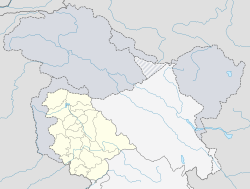Khalatse
|
Khaltse Khalatse |
|
|---|---|
| village | |

School kids in Khalatse
|
|
| Location in Jammu and Kashmir, India | |
| Coordinates: 34°19′12″N 76°52′45″E / 34.3200775°N 76.8793025°ECoordinates: 34°19′12″N 76°52′45″E / 34.3200775°N 76.8793025°E | |
| Country | India |
| State | Jammu and Kashmir |
| District | Leh |
| Tehsil | Khalsi |
| Elevation | 2,987 m (9,800 ft) |
| Population (2011) | |
| • Total | 767 |
| Time zone | IST (UTC+5:30) |
| 2011 census code | 948 |
Khaltse or Khalsi is a village in the Leh district of Jammu and Kashmir, India. It is located in the Khalsi tehsil, 337 km from Srinagar on the old main road to Leh, where it crossed the Indus over an iron bridge. Much of its importance is because it is the place where the road from Kashmir debouches into the Indus Valley. Close by are the remains of an old fortified customs house.
There is a fragmentary inscription at Khalatse which carries the name 'Maharaja Uvima' which is attributed to the Kushan king, Vima Kadphises who ruled in the 1st or early 2nd century CE.
Lha chen Naglug (c. 1150-1175 CE), a member of a dynasty of Dard kings, a built a bridge across the Indus at the same site as the present bridge, and the Bragnag castle on the bank of the Indus, on the brook, about one mile (1.6 km) above the present village, to guard the bridge. It was built in competition to another bridge, the Babu Khar bridge, only three miles (4.8 km) away, and was clearly built to raise taxes from travellers. The castle is said to have been the first castle built in the country. The ruins of the castle and also the remains of extensive fields and watercourses are still visible. Lha chen Naglug also built the palace at Wanla.
There are a number of ancient Dardic rock carvings nearby, including one of a Dard woman carrying a basket on her back, one of a man hunting antelopes, and some showing men with what appear to be flat hats, all costumes similar to the Dards of Da. In front of the ancient Dard castle at Khalatse is an inscription in an Indian language which probably dates from the period of Dard occupation.
The German Moravian Church Mission, which opened in Leh in 1885 had a sub-station in Khalatse which remained open for the half a century prior to India's independence in 1947 and played a prominent role there with their medical and educational activities, but only made a few converts.
Entering Khaltse by the road from Srinigar, it is clear one is entering the heartland of Buddhism with its chortens or small stupas, mani stones and prayer flags. Upstream from Khalatse, and downstream on the right bank of the Indus, the people are almost all Buddhist. The ones downstream are mostly Brokpa or Dards. Khalatse is also famous for its apricots.
...
Wikipedia


